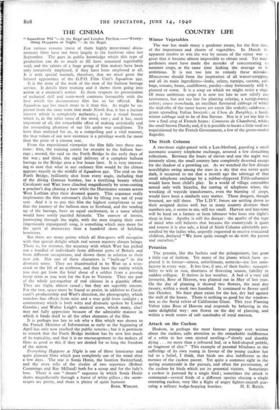THE CINEMA si Squadron 992 "—At the Regal and London
Pavilion.—"Every- thing Happens at Night."—At the Regal.
FOR various reasons (most of them highly mysterious) docu- mentary films have not been largely to the forefront since last September. The gaps in public knowledge which this type of production can do so much to fill have remained regrettably void, and the talents of a large group of film makers have been only tentatively employed, if they have been employed at all. It is with special warmth, therefore, that we must greet the belated appearance of the G.P.O. Film Unit's Squadron 992.
It is the story of the work of the men of the balloon barrage service. It details their training and it shows them going into action at a moment's notice. In these respects its presentation of technical skill and team-work contrasts favourably with the best which the documentary film has so far offered. But Squadron 992 has much more to it than this. As might be ex- pected from the same team that made North Sea, it has a human interest which is completely authentic ; it has a visual beauty which is, in the strict sense of the word, rare ; and it has, most important of all, the remarkable effect of making artistically real the astounding phantasy of our life under war conditions. To have thus analysed for us, in a compelling and a vital manner, the true values of our new existence is a privilege worth far more than the price of a cinema seat.
From the expositional viewpoint the film falls into three sec- tions : first, the training centre for recruits to the balloon bar- rage ; second, the raid on the Forth Bridge in the early days of the war ; and third, the rapid delivery of a complete balloon barrage to the Bridge area a few hours later. It is very interest- ing to note that what in any ordinary film would be the climax appears exactly- in the middle of Squadron 992. The raid on the Forth Bridge, brilliantly shot from every angle, including that of the diving German bomber, has a terrifying beauty which Cavalcanti and Watt have clinched magnificently by cross-cutting a poacher's dog chasing a hare while the Hurricanes scream across West Lothian after their doomed quarry. This sequence really implements the film salesman's cliché by lifting you out of your seat. And it is to pay this film the highest compliment to say that the journey of the balloon men to Scotland, and the sending up of the barrage, have an equal excitement, in a sense which would have sorely puzzled Aristotle. The convoy of lorries, journeying through the night, with the men singing their own (ingeniously expurgated) song, is something which says more for the spirit of democracy than a hundred shots of belching howitzers.
But there are many points which all film-goers will recognise with that special delight which real screen mastery always brings. There is, for instance, the accuracy with which Watt has picked out a handful of individuals from different parts of Britain and from different occupations, and shown them in relation to their new job. Not one of these characters is " built-up " in the dramatic sense. They are thumbnailed in by Watt on a wise- crack or the lift of an eyebrow, and they have the reality which you may get from the brief shout of a soldier from a passing troop train as you wait for the 8.2o to Victoria. They are part of the whole get-together of real citizens in a gigantic effort. They are slight, almost casual ; but they are superbly sincere. For the rest, space must be found to praise, in addition to Caval- canti's producership and Watt's direction, the photography, which snatches fine effects from mist and a true gold from sunlight ; a commentary which is both witty and dramatic spoken by Lionel Gamlin ; and Walter Leigh's musical score, which many, alas! may not fully appreciate because of the admirable manner in which it binds itself to all the other elements of the film.
It is perhaps too late to ask why a film which was shown to the French Minister of Information as early as the beginning of April has only now reached the public screens ; but it is pertinent to remark that the Forth Bridge incident has by now lost much of its topicality, and that it is no encouragement to the makers of films as good as this if they are denied for so long the freedom of the screen.
Everything Happens at Night is one of those innocuous and quite pleasant films which pass completely out of the mind after a few days. The star is Sonja Henie, the location Switzerland, and the story tells of the rivalry of two reporters (Robert Cummings and Ray Milland) both for a scoop and for the lady's love. There is one " dream " sequence in which Sonja Henie skates magnificently through a forest of white pillars ; the snow- scapes are pretty, and there is plenty of quiet humour.
BASIL WRIGHT.






























 Previous page
Previous page